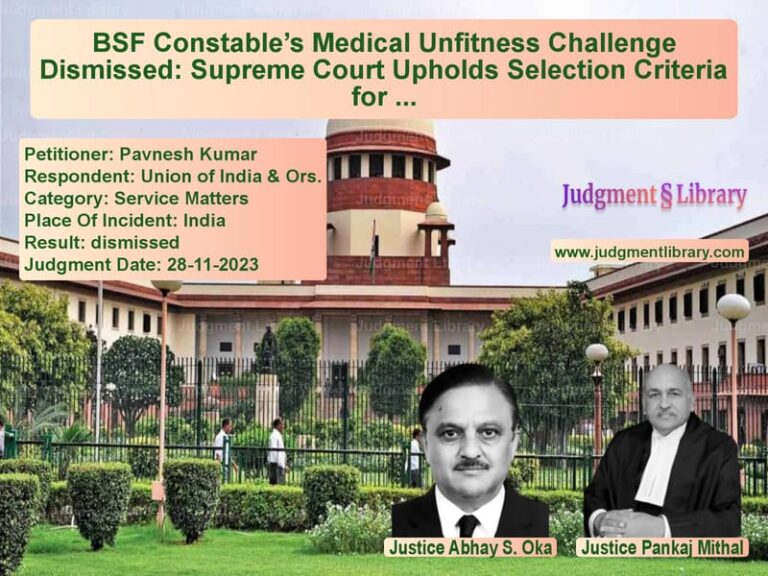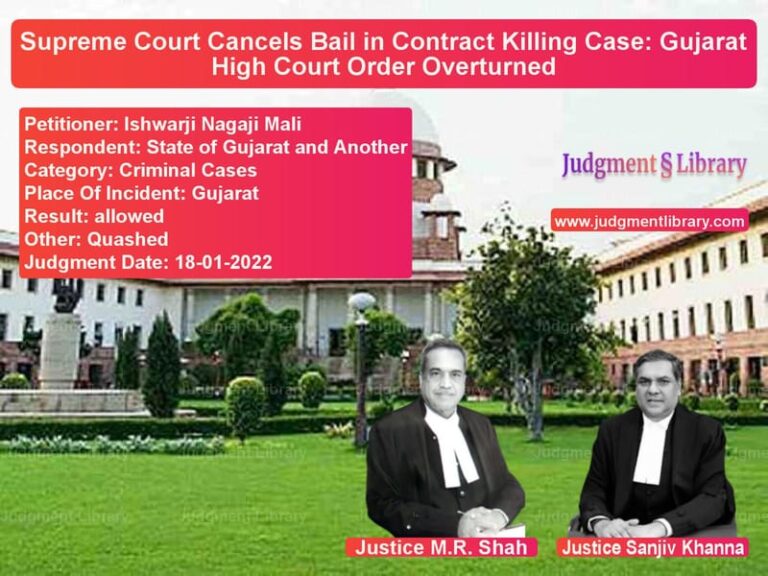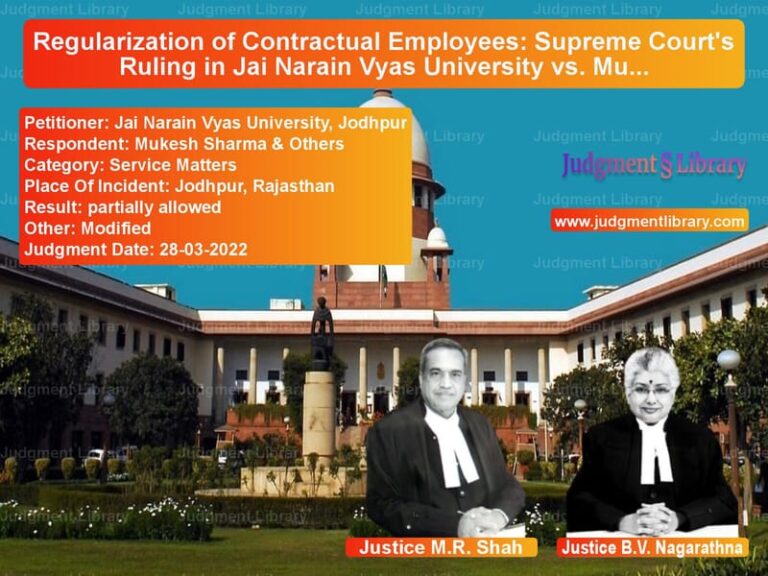Functional Disability Over Statutory Figures: Apex Court Upholds Just Compensation for Mutilated Hand
When Kamal Dev Prasad, a forging machine operator, lost significant functionality of his dominant right hand due to a horrific workplace accident, he approached the Employees’ Compensation Commissioner seeking relief under the Employees’ Compensation Act, 1923. What followed was a contentious legal journey marked by disputes over statutory schedules, the need to evaluate actual disability over theoretical benchmarks, and the very essence of judicial interpretation in awarding just compensation. The Supreme Court of India, in its landmark ruling dated April 29, 2025, set the tone for recognizing the realities of physical trauma, revising the High Court’s mechanical reliance on statutory figures and restoring a higher compensation that reflected the actual loss in the worker’s ability to earn.
The Accident and Its Impact
Kamal Dev Prasad had been employed with Mahesh Forge since April 5, 2002. On November 6, 2004, while operating a forging machine, a part of the equipment fell on his hand. In an attempt to remove the band of the handle lock, his right hand was caught in the machine. The injuries were severe. He remained hospitalized until December 24, 2004. The accident resulted in the loss of one phalanx of his little finger, two phalanges of the ring finger, three phalanges of the middle finger, and two and a half phalanges of the index finger—all on his right hand. As a result, his hand was severely mutilated and rendered functionally deficient for any further work as a forging machine operator.
The Commissioner under the Employees’ Compensation Act awarded full compensation acknowledging 100% disability and determined the compensation as ₹3,20,355. An additional 50% of this amount (₹1,60,178) was granted as penalty due to the employer’s delay in payment. Interest at 12% from the date of the accident was also awarded. The employer, dissatisfied with this, appealed the decision.
The Employer’s Argument and High Court Ruling
Mahesh Forge, the employer, contended that the disability suffered by the worker did not amount to 100% as determined by the Commissioner. They argued that the injuries were explicitly listed in Part II of Schedule I of the Employees’ Compensation Act, which provided specific percentages for each type of injury. According to the employer, the total loss, based on these statutory percentages, amounted to only 34% loss of earning capacity. The High Court accepted this contention and drastically reduced the disability figure to 34%, thereby reducing the compensation awarded.
Petitioner’s Argument in Supreme Court
The petitioner, through his counsel Ms. Vidya Vijaysinh Pawar, strongly challenged the High Court’s decision. It was argued:
“The loss of earning capacity is not merely to be determined by the statutory percentages assigned to each finger. It must be judged in context to the functional ability of the person to continue working in his trade, which in this case was machine forging.”
She further submitted:
“The High Court erred in ignoring the fact that all four fingers on the appellant’s dominant hand were mutilated, affecting his complete grip and functionality, thereby making it impossible for him to continue as a forging machine operator.”
Respondent’s Submission
Mr. Amol Chitale, appearing for the employer, contended that:
“When Schedule I to the Act specifically lists the injuries and the corresponding percentage of loss of earning capacity, courts must follow it unless there is certified medical evidence showing greater disability.”
He highlighted the absence of a medical certificate attesting 100% disability and reiterated that the Commissioner and High Court had to rely on the statutory framework in such cases.
Supreme Court’s Observations
The Supreme Court bench, comprising Justices Sudhanshu Dhulia and K. Vinod Chandran, delved deeply into the relationship between statutory interpretation and real-world application of compensation laws. It began by referencing the ruling in Oriental Insurance Co. Ltd. v. Mohd. Nasir (2009) 6 SCC 280, wherein it was held that both the Workmen’s Compensation Act and the Motor Vehicles Act are beneficial legislations meant to provide relief to accident victims and should be interpreted liberally.
Addressing the statutory schedule, the Court stated:
“While determining the amount of loss of earning capacity, the Tribunal or the High Court must record reasons for arriving at their conclusion.”
In cases where multiple fingers are damaged, each leading to a significant overall impact on hand functionality, it would be erroneous to merely sum up the statutory percentages. The Court found that the total loss of phalanges amounted to a statutory disability of 37%, not 34% as previously held. But more crucially, the judges recognized the concept of functional disability over and above statutory loss:
“The disability as determined by the statute is for the specific loss of a phalanx or a finger and in the event of more than one such loss it cannot be said that a mere aggregation would determine the actual loss.”
Although the employee had not produced a separate medical certificate attesting to functional disability, the Court held that the injuries were self-evident. The complete loss of grip in the operational right hand rendered the employee unfit for his earlier occupation. They said:
“Functionally it is difficult for the right hand to be used with the same grip as available prior to the accident. Though a 100% disability cannot be assessed, insofar as the mutilation of the one hand which is also the operational hand, the right hand, we are inclined to determine the loss at 50%.”
Final Compensation Recalculated
The Court recalculated compensation based on a 50% disability rate. Using the formula under the Employees’ Compensation Act:
₹2,500 (monthly wage) × 60% × 213.57 = ₹3,20,355
50% of ₹3,20,355 = ₹1,60,177.50
The employee was also entitled to:
12% interest from the date of accident
Penalty amounting to 50% of compensation = ₹80,088.75
If the amount as per the High Court’s earlier ruling had already been paid, the employer was ordered to pay the balance along with applicable interest and penalty. This adjustment ensures the claimant receives just compensation that matches his actual ability to earn and support himself post-accident.
Final Verdict
In conclusion, the Court pronounced:
“The appeal stands allowed with the above directions.”
The Supreme Court thus restored justice by striking a balance between rigid statutory schedules and the real-life challenges faced by injured workers. The Court showed that even without a medical certificate, obvious facts supported by the nature of the accident and occupation could substantiate enhanced compensation.
Conclusion
This judgment has far-reaching consequences in workers’ compensation jurisprudence. It clarifies that statutory percentages listed in the Schedule cannot override the functional realities of the injured person. By recognizing functional disability over mechanical calculations, the Court has empowered workers to claim fair and just compensation that reflects the ground reality of their injuries. The case also reaffirms the principle that beneficial legislation must be interpreted with a humane and practical approach, especially when dealing with the livelihoods of vulnerable workers. This ruling sets a precedent for future cases where multiple minor injuries aggregate into a major occupational handicap, demanding a holistic and realistic assessment by the judiciary.
Petitioner Name: Kamal Dev Prasad.Respondent Name: Mahesh Forge.Judgment By: Justice Sudhanshu Dhulia, Justice K. Vinod Chandran.Place Of Incident: Not specified, workplace accident during machine operation.Judgment Date: 29-04-2025.Result: allowed.
Don’t miss out on the full details! Download the complete judgment in PDF format below and gain valuable insights instantly!
Download Judgment: kamal-dev-prasad-vs-mahesh-forge-supreme-court-of-india-judgment-dated-29-04-2025.pdf
Directly Download Judgment: Directly download this Judgment
See all petitions in Compensation Disputes
See all petitions in Damages and Compensation
See all petitions in Contract Disputes
See all petitions in Judgment by Sudhanshu Dhulia
See all petitions in Judgment by K. Vinod Chandran
See all petitions in allowed
See all petitions in Modified
See all petitions in supreme court of India judgments April 2025
See all petitions in 2025 judgments
See all posts in Civil Cases Category
See all allowed petitions in Civil Cases Category
See all Dismissed petitions in Civil Cases Category
See all partially allowed petitions in Civil Cases Category







